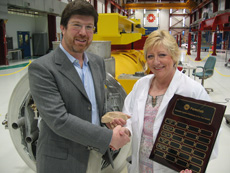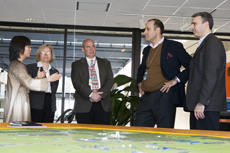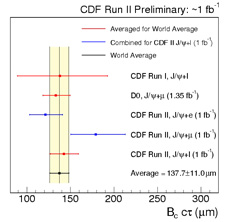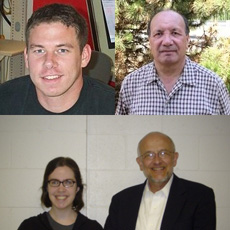|
Thursday, May 1
THERE WILL BE NO PHYSICS AND DETECTOR SEMINAR THIS WEEK
2:30 p.m.
Theoretical Physics Seminar - Curia II
Speaker: S. Grab, Universität Bonn
Title: Sneutrino or Stau as the Lightest Supersymmetric Particle in mSUGRA with R-Parity Violation
3:30 p.m.
DIRECTOR'S COFFEE BREAK - 2nd Flr X-Over
THERE WILL BE NO ACCELERATOR PHYSICS AND TECHNOLOGY SEMINAR TODAY
Friday, May 2
3:30 p.m.
DIRECTOR'S COFFEE BREAK - 2nd Flr X-Over
4 p.m.
Joint Experimental-Theoretical Physics Seminar - One West
Speaker: M. Boezio, INFN Trieste
Title: The Science of the PAMELA Space Mission
8 p.m.
Fermilab International Film Society - Auditorium
Tickets: Adults $5
Title: Sketches of Frank Gehry
Saturday, May 3
8 p.m.
Fermilab Arts Series - Auditorium
Tickets: $25/$13
Reduced Shakespeare Company: All the Great Books (abridged)
Click here for NALCAL,
a weekly calendar with links to additional information.
|
Thursday, April 24
- Minnesota wild rice w/chicken
- Tuna melt on nine grain
- Italian meatloaf
- Chicken casserole
- Vegetarian salad wrap
- Assorted pizza slices
- Mandarin chicken
Wilson Hall Cafe menu |
|
Thursday, May 1
Dinner
- Sea scallops w/maple cream
- Grilled pork tenderloin w/Madeira cream sauce
- Steamed asparagus
- Roasted garlic mashed potatoes
- Profiteroles w/strawberries
Wednesday, May 7
Lunch
- Crepes w/Black Forest ham & Gruyere
- Greek salad
- Cold lemon soufflé
Chez Leon menu
Call x4598 to make your reservation. |
|
|
Hicks wins 2007 Fermilab Industrial Hygiene Award

Donna Hicks receives the Safety Award from Giorgio Apollinari, TD head, in front of a 1.3 GHz cryomodule. Hicks helped to make safer the chemical processing needed to optimize the performance and operation of the superconducting cavities in the cryomodule.
When Donna Hicks learned that she was the recipient of the 2007 Fermilab Industrial Hygiene Award, she was surprised.
"It takes a dedicated group of workers to make the workplace safe for everybody. It's not just me," she said.
Hicks, a Technical Division employee, won the award for her efforts and contribution to the Material Development & Test Laboratory refurbishment and upgrade, which allowed personnel to safely perform buffered chemical polishing and electropolishing on an R&D level. The award is given annually to an employee or a group whose efforts and support have done the most in development and furthering Fermilab's Industrial Hygiene program.
Buffered chemical polishing and electropolishing use concentrated acid mixtures in their processes, particularly hydrofluoric acid, an extremely hazardous substance. Other acids used are nitric, sulfuric and phosphoric acids. Hicks was instrumental in writing procedures for the safe handling and use of these concentrated acids at the MDTL, including the following procedures: acid mixing, detailed operating procedures for each process, emergency response, first aid and spent-acid waste handling.
She also researched the most effective personal protective equipment to use against the concentrated acids, particularly hydrofluoric acid. Personnel handling hydrofluoric acid now have the highest level of protection possible, and Hicks thoroughly trains them on its use as well as on the procedures listed above.
"Safety is ingrained in everything we do," Hicks said. "It's an ongoing process and I don't think it ever ends."
|
DOE CFO tours Fermilab

On Wednesday, DOE Chief Financial Officer Steve Isakowitz (right) and DOE
Deputy CFO Owen Barwell (second from right) toured Fermilab before heading
to a meeting at Argonne National Laboratory. Joining them for the tour were
(from left) Fermilab Deputy Director Young-Kee Kim, Fermilab CFO Cindy
Conger and Mark Bollinger, deputy manager of the DOE Fermi Site Office.
|
The World Wide Web turns 15 (again)
From BBC News, April 30, 2008
The World Wide Web has many birthdays.
March 1989, when Tim Berners-Lee handed his boss a short document entitled Information Management: a Proposal, is one.
Christmas of the following year, when the Web was up and running on two computers, is another.
But perhaps the most important Web anniversary of all is April 30, 1993.
That's the day that Cern put the web in the public domain, thereby ensuring that the world would have a single system for accessing the Internet, instead of a Microsoft Web, a Macintosh Web and who knows, perhaps even an Amstrad Web.
Today, it is hard to imagine a world without the web, yet well into the 1990s, Internet access was the reserve of the privileged few, mainly academics.
Although the internet had been around since the 1970s, accessing documents on remote computers required the mastery of complex protocols. Scientists had been doing that for years, and at Cern, the European laboratory for particle physics in Geneva, they were particularly adept.
Read more
|
Searching for an elusive particle, physicists take a shot in the dark
From Scientific American, April 29, 2008
Experimenters team up in the search for an invisible, hypothetical particle
Earlier this month, Italian researchers made a claim that, if taken at face value, would earn them a place in scientific history. The DAMA (DArk MAtter) collaboration, based at the University of Rome, announced at a scientific meeting in Venice that it had directly detected dark matter-the invisible, nigh undetectable stuff believed to give added heft to galaxies.
Although other researchers in the field place little confidence in the report, which clashes with their own experimental results, it does highlight the progress and challenges in searching for an elusive quarry that may not actually exist. The efforts of dark-matter hunters are much like the shadowy stuff itself: easily overlooked, but exerting a slow and steady effect.
Physicists know that something has imparted galaxies with more spin than they should have if composed solely of regular "baryonic" matter, the visible stuff of stars and planets. To explain the discrepancy, most look to a hypothetical blizzard of nonbaryonic matter, neither absorbing nor emitting light, swirling around every galaxy. Astronomical measurements imply that this dark matter makes up 23 percent of the universe, compared with visible matter's measly 4 percent share.
Read more
|
|
|
A doubly heavy matter

Bc lifetime measurements from CDF Runs I and II as well as DZero. The CDF Run II result shows the lifetime for muon and electron final states separately, as well as the combination of the two final states. A weighted average of results yields the preliminary world average. The combined CDF Run II lepton result is used in the weighted average.
Usually, the B mesons you hear about are composite particles made of light up, down or strange quarks and a much heavier bottom quark. These heavy quarks dominate the properties of the meson, such as mass and lifetime.
Matters are different for the Bc meson, which consists of two heavy quarks: a bottom and a charm quark. The doubly heavy composition of the Bc means that its lifetime is shorter than that of the lighter B mesons. The bottom quark can decay into lighter quarks, and the charm quark can also decay. These decays result in more decay options and a shorter lifetime for the Bc than for other B mesons. The Bc mass is heavier than the mass of other B mesons, which gives the Tevatron a monopoly on its study, since it is the only accelerator with enough energy to produce it.
Measuring the lifetime of the Bc improves our understanding of bare quark properties such as quark masses and the strong interactions that bind quarks to each other.
CDF researchers measure the Bc lifetime using decays to a J/ψ meson, a lepton and a neutrino that goes undetected. Scientists identify Bc meson candidates as events with a J/ ψ meson that decays into two muons. In order to get a measurement of the lifetime, CDF scientists perform a fit to the candidate events.
With one inverse femtobarn of data, CDF researchers measure a Bc lifetime of 0.475 +0.053-0.049(stat.)+/-0.018 (syst.) picoseconds, nearly four times shorter than that of the B+ meson. This measurement combines final states with electrons and muons and represents a level of precision competitive with the world's best measurement. The measurement confirms the theoretical prediction that the Bc should have a short lifetime. By peering through the microscope of this and other Bc measurements, we bring into focus the properties and interactions of the quarks in one of their most interesting environments.

From left at top: Mark Hartz and Turgun Nigmanov. From left at bottom: Karen Gibson and Paul Shepard. All are from the University of Pittsburgh.
Learn more
Result of the Week Archive
|
|
In the Friday, April 25 issue of Fermilab Today, we misidentified Anne Mary Teichert as Mary Anne in in a photo caption about a painting for the Family Outdoor Activity Fair. Fermilab Today regrets the error.
|
|
Have a safe day!
Interaction Management course
Through practice and feedback for supervisors and managers, this course will teach the essential skills and discussion guidelines necessary for effective coaching. Learn more and enroll
Performance Review course
This course benefits managers and supervisors who conduct performance reviews. You must complete the Interaction Management course before participating. Learn more and enroll
NALWO Spring Tea May 5
Members of the Fermi National Accelerator Laboratory Women's Organization will hold their Spring Tea on May 5 from 11 a.m. - 1 p.m. Barbara Oddone will host the event in her home, Site #29, located just inside the Wilson Street gate. Photo identification is necessary to enter the laboratory. When entering at Wilson Street, turn right at the driveway just beyond the gate. If possible, please bring a favorite dessert or appetizer from your home country. For additional information, contact Susan Kayser, Margie Nagaitsev or the Housing Office at (630) 840-3777.
International Folk Dancing May 1
International Folk Dancing returns to Kuhn Barn this week, Thursday, May 1. Dancing begins at 7:30 p.m. with teaching and children's dances followed by request dancing. Newcomers are welcome. You do not need to come with a partner. Information at (630) 584-0825 or (630) 840-8194 or folkdance@fnal.gov.
Additional Activities |
|